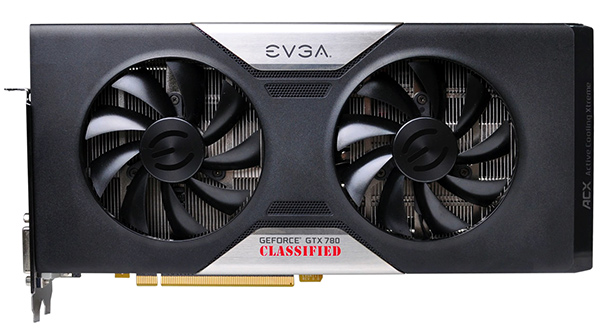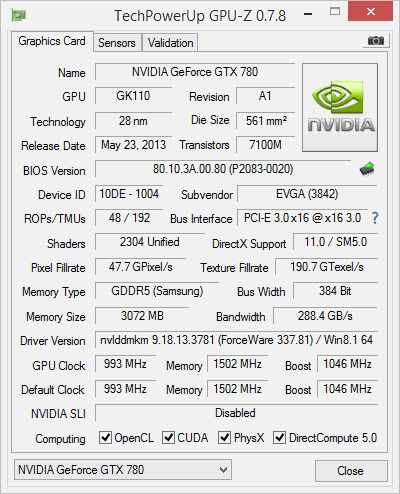Index


Review: Enough power to defeat GTX 780 Ti
The EVGA GTX 780 Classified has been dethroned as the company’s fastest non-Titan card following the introduction of the GTX 780 Ti Classified, which became the new alpha dog.
However, even the plain GTX 780 Classified is still a very attractive card and here is why. As the Ti launched and superseded the GTX 780, it became quite a bit cheaper. Right now you can pick up a GTX 780 Classified for about €70 less than a reference GTX 780 Ti card and it’s a whopping €200 cheaper than the GTX 780 Ti Classified.
The GTX 780 debuted at €620 and today you can have the GTX 780 Classified for €480.

EVGA’s Classified series cards are known for their all-custom PCBs and spruced up power components, which provide more power stability and overclocking potential. As a result, we were able to squeeze out a lot of performance out of the card and beat the reference GTX 780 Ti. The custom cooler is quiet, too. The ACX cooler features a huge heatsink and two 90mm fans.
Before we move to test results let’s refresh our memory. If you know enough about the GTX 780 save your time and feel free to skip to the next page.
Nvidia’s Kepler architecture has been around for a while. Kepler was officially launched in March 2012 and became known as the Geforce 600 series. The top of the line was the GK104-based Geforce GTX 680 card that stood its ground for quite some time. This was a 28nm chip that stayed with us for years and it’s on sale even today in GTX 760 / 770 based mainstream cards.
Then the world’s attention shifted to the GK110, a massive new chip that was announced at Computex 2012 and finally released in November 2012 as the Tesla K20 compute card. This one was based on the brand new, 7-billion transistor GK110 28nm core.
The gaming world met the GK110 chip in late February 2013 as it debuted in the fastest graphics card at the time, the Geforce GTX Titan. The Titan has 6GB of GDDR5 memory, 2688 Shader processors, 224 texture mapping units and 48 ROPs or render output units. The card is clocked at 837MHz base clock and 876 MHz boost clock and was the fastest card for some time. The problem was the $999 price which was enough to burn a huge hole in most wallets.
It is interesting to note that the Titan got a lot of flak for its price, but that did not deter Nvidia. In fact, the company launched an even more expensive card this year, the $2,999 Titan Z.
The Geforce GTX 780 was the first desktop card in the GTX 700 series and the first mass market implementation of the GK110. It launched in May 2013, with 2304 CUDA cores, 863MHz base GPU clock, 192 texture mapping units (TMUs), 48 render output units (ROPs) and 3GB of GDDR5 memory running at 1502MHz on a 384-bit memory bus. The EVGA GTX 780 Classified works at a 993MHz base clock, which points to a significant performance boost over reference cards. Unfortunately the memory is still running on reference clocks, i.e. 6008MHz (effective GDDR5). This is typical of EVGA, since the company rarely overclocks memory.
Basically the GTX 780 is a watered down Titan. The GK110 is made out of clusters and Titan has 14 clusters with 192 Shader cores each. The Geforce GTX 780 has 12 of these cores enabled and the new comer Geforce GTX 780 Ti comes with a record number of 2880 shades, which translates to 15 clusters enabled.
Specification wise the GTX 780 ended up with 50% more CUDA cores than its predecessor, the GTX 680. This among other things gives the GTX 780 card a significant performance boost, although the GK110 is based on the Kepler architecture used in the GTX 680. The GK104 chip used in the GTX 680 has 1536 CUDA cores. The GTX 780 has a 384-bit bus while the GTX 680 is limited to a 256-bit interface, but the memory speed on both cards is 6008MHz.The frame buffer was increased from 2048MB to 3072MB of GDDR5 memory.
Compared to the GTX Titan ($999), the GTX 780 debuted at a more attractive price of $649. Nvidia’s response to AMD’s new R9 290X was to slash the price of the GTX 780 by $150 and launch the full GK110 Geforce GTX 780 Ti.

